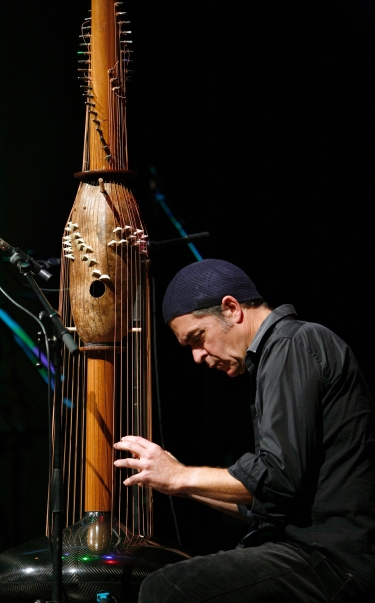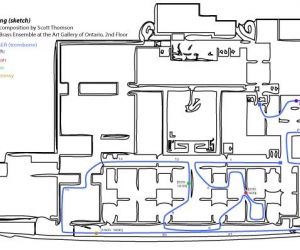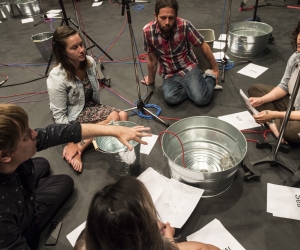Wherever Victor Gama plays, you can be sure clusters of people will be jostling to percuss the upturned metal bowls of his tipaw (so called because the surface of the instrument looks like the pads of a tiger paw), to bow the eight metal strings of the tahra, or simply to wander the length of the GigantikArpz, a long string installation that uses piano strings at lengths between twenty and 160 metres, produces low, low harmonics, and is vaguely in the lineage of composer Ellen Fullman’s own monumental creation, the Long String Instrument. Just to look at Gama’s inventions—what he refers to as pangeia instrumentos—that come out of the Musical Instruments and Technology and Innovations Laboratory (MITAIL), Gama’s design studio, is to wonder at the architecture of the instruments—their fluid and organic geometries—as much as at their range of sounds and the compositions informed by them.
Why do composers need new instruments? What happens when new ones are created? These aren’t academic questions aimed at musicologists or organologists, but far-reaching ones for a wide listening and performing community. Both questions are at the very heart of the practice of Gama, an Angolan-Portuguese composer and instrument maker living near Lisbon. “New instruments create a paradigm shift,” Gama says. “You can make your own soundworld.” In his studio, where he can design a virtual instrument on his computers as a precursor to making a real-world physical one, an endless interplay can be set up. It’s this constant experimentation that yields the pangeia instrumentos. “[On the computer] I can very quickly generate new instruments that have their own libraries of sounds and offer a new interface,” he says.
But this is not the end of things. The creation of a physical instrument from its virtual shadow is the real game. “The post-digital world is circling back to its object,” Gama says. It’s an acknowledgment that, in some ways, digital music has become unharnessed from its physical counterpart, with implications for the greater context that music exists in. This linked relationship is what Gama theorises as Golian Modes. It’s a theory linking idea and design, and is central to Gama’s entire range of music-making: it envelops composition and both virtual and real instruments. The original impetus for Golian Modes came out of Gama’s Odantalan Project, a wide-ranging research in Angola that studied the holistic nature of the knowledge systems of the ancient Kingdom of Kongo, in particular the n’kizi, a concept that straddles physical and spiritual worlds. Brought up to date, this becomes a way to signal the dynamic relationship between the real and virtual.
This approach has gained many adherents. Gama’s compositions have been performed worldwide. The Kronos Quartet, for whom he wrote
Rio Cunene (2010), and the Chicago Symphony Orchestra are just two groups of stellar musicians with whom he has collaborated. And his instruments have been exhibited at numerous galleries and museums, including the Royal Opera
House in London, the Gulbenkian Foundation in Lisbon, and the National Museum of Scotland in Edinburgh, where a collection of his instruments was chosen to reinvigorate the Performance and Living galleries.
For Gama, instruments are complex things: they are part of a history, a social construct. “I think of my instruments as performing mediators in the sense that they have been designed from a set of meanings, myths, and symbols, with the aim of allowing me to enter a new cosmological realm, meaning a reality that integrates both the real and the virtual, the physical and the spiritual, without boundaries and preconceptions. That is where I think the work of music has a real advantage, in that it allows you to go through your own conceptual constraints.”
There is, in Gama’s emphasis on music as being part of a social whole, an echo of medieval harmony—when music, mathematics, geometry, and more besides, were part of an entire system of knowledge.
“I use the term musician-citizen to convey a somewhat different meaning for the work that certain musicians do through their music,” Gama says. “The musician-citizen would be someone who sees and engages with music as an overarching work that feeds and reflects on the social, political, and historical realities of the societies and environments he lives in. In my case, I live in—and my work reflects on—patches of societies and countries from Angola to Colombia, to Portugal, Brazil, Cuba, South Africa, the U.K., and the U.S., although I’ve found myself increasingly interested in and looking into—rooted in, even—the historical and cultural realities of Angola from precolonial times to today. I see a musician-citizen as somewhat related to an investigative journalist, reporting on what’s happening around him, irrespective of national borders.”
This investigative role plays out on various levels. It’s present in collaborative works with, for example, jazz improvisers Naná Vasconcelos and William Parker, and experimental musicians David Gunn and Max Eastley, and also in social instruments such as the toha or tahra, which can be operated by several players simultaneously. It’s an investigation that stretches into the realm of music as a creative, social force. One of the most insightful projects Gama has worked on is Folk Songs for the Five Points (2005), an interactive Web-based work initiated by Gunn during his period as the digital artist in residence at New York’s Tenement Museum. Taking cues from the city, and the idea that people encase memory via sounds and songs, Gama wrote songs and Gunn made field recordings at various locations on the Lower East Side. It was a way of engaging with the sense of an area being enriched with a continuous emigration, as well as an invitation to Web visitors to create their own soundmaps by mixing some of the sounds that are on the site, which include snatches of conversation, hisses of steam, singing, and instrumentals.
However, it is in Tsikaya, a continuing recording project Gama began in Angola in 1997, that the role of the musician-citizen is most explicit. “The interior of Angola,” Gama says, “is still quite isolated, and radio stations are limited, so there are not many means for people to promote their own music.” But what began as a relatively simple open-mike project to bring recording opportunities into the interior of the country—to, in Gama’s words, “awaken a silent zone”—was soon overturned by civil war. When the region became safe enough to visit again, Gama found that musicians in the interior had responded to the near-collapse of infrastructure—and consequently, trading routes—in the region by developing their own creative solutions to enable music-making. Bits of a tank have been used to make a guitar; pebbles added to empty gun-magazines to make shakers, and oil containers turned into drums. The music made by the Tsikaya participants (the project is supported by a commendable Web site) was varied, but it located itself into bigger rhythms and themes in a way that would not be unfamiliar to a listener au fait with a Steve Reich soundworld.
These are tender, ruminative projects, but Gama has the capacity for rage in his focus on the geopolitical. In
Vela 6911—a multimedia work for orchestra, toha, acrux, and film, commissioned for the Chicago Symphony Orchestra and premiered in 2012—Gama’s artistic response is dramatic and elegiac. Vela 6911 was a U.S. satellite that, in 1979, recorded two flashes of intense light in the South Atlantic—the result of a secret nuclear test conducted by apartheid-era South Africa and, possibly, Israel. Vela 6911 is based on the diaries of Lindsey Rooke, a South African naval officer who witnessed what Gama refers to a “cosmic big bang of terrible consequences for man and nature, a simulation of the end of the world.”
There’s a terrible urgency written all over Vela 6911: visual footage of the Antarctic region over which the bomb was exploded shows the majestic area in all its potential vulnerability, while the sounds of conventional orchestra and Gama’s pangeia instrumentos unite two streams of music-making. And as metaphor for Gama’s work, it cannot be bettered.
Read Louise Gray's companion stories on two of Victor Gama's pangeia instrumentos,"The Toha" and "The Acrux," in the print edition of Musicworks #118.
Photo (Top): Composer and instrument maker Victor Gama plays the toha. Photo by: Najib Nafib. Audio: Running With The Herd. Composed and performed by: Victor Gama.



